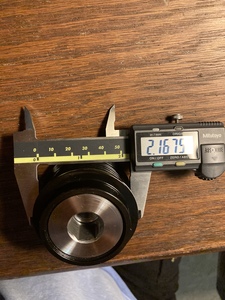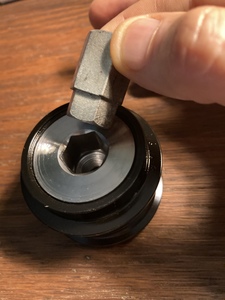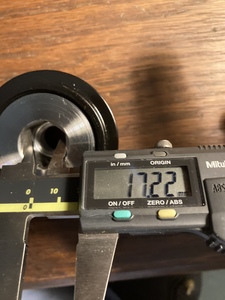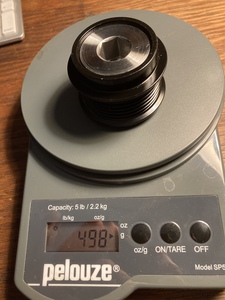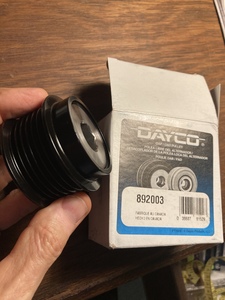Although technically off topic I think, because we have been comparing things; I have a lightweight crank pulley underway.
The harmonic damper up front is a túned balancer as has been observed. It is tuned to a specific rev range to smooth out the torsional imbalance at thóse revs; it does not work at other revs. Note that the torsional imbalance is primairily caused by the combustion bangs on the pistons. It follows that tuning the engine, changing the bangs, affects the torsional harmonics, détuning the tune of the pulley.
In my case I have more flow (big blue intake hole and free flow exit) plus a shifted torque curve because of the MAF mod. so decided to remove the in effect detuned 1.660 gram lump 😊 in favour of a 350 gram thingy.
There is another thing to take into account:
There is a whole lot of weight being pushed and pulled around by the pulley by means of a belt. How´s that for a harmonic damper 😉
Now switch on the a/c and bear in mind the force it takes to drive it.
Ditto a lighter underdrive alternator pulley or a twice as heavy decoupling one.
All in all, when we start modding the car, the harmonic argument becomes a moot one.
Finally after so much wait the part is here. I will probably install it tomorrow.
Looking forward to your report.
@petrus The OEM pulley is not a balancer of any kind. IT is a torsional damper. A crankshaft has several modes of torsional vibration that are a function of the cylinders firing and the masses on the crankshaft (especially the flywheel). Changing the tune of the engine will have no effect on the natural frequency of the crankshaft's modes, just the level of excitation at full power. The OEM pulley functions as a broad-band damper and so it dampens down all of the natural modes of vibration, but the tuning is done to maximize the effect at the most highly stressed modes (the speeds where the measured crank twist is highest). It is true that the accessory drive alone does offer some damping, but if that were enough to protect the crankshaft, every OEM in the world would not use crank pulley dampers.
Your argument that modding the engine undoes the benefit of the OEM damper is just incorrect. To sumarize the reasons:
1) the damper is tuned but it is very broadband (it is even effective with a lightened flywheel)
2) You haven't appreciably changed the excitation of the crankshaft, or it's vibration modes, or its fatigue strength
Dave
Looking forward to your report.
Unfortunately I'm going to be delayed and I apologies. I have too much on my table now to finish up before I can get to the car. I hope to get to it this weekend.
One interesting thing to note, they sent me the Litens 920834 in the Dayco box. The cross reference is correct and when I examine the pictures it would seem they look identical just relabeled. However the Toyota ones look a little different and could be a different manufacturing house.
Again thank you Dave, much appreciated.
As to cars having them or not, quite a few do not. Of the four cars in the family; two with Renault engine one with Merc, the Spyder is the only one that has it. Even on japanese cars they are not a given.
The pulley I am using is a Litens as well.
Thats good to know. I was in two minds of sending it back even though the application matches. If this works it would be much cheaper to buy the Litens part.
For the next few days I will be busy testing out my new camera that I wanted for the last 25 years so Im going to be in a different mindset and do not want to ruin my impressions of this pulley. Once that kid on Christmas shiny newness settles down I can then properly do this mod justice. Maybe have the pictures from that camera for the write up when the time comes.
Dev et al., it might be nice to know the weights of each - OE and Liftens/Dayco.
I believe marsrock7 may have already done so but I will do it again for sure.
I really do not think just having it lighter or heavier makes all that much difference even if its a fixed pulley however having it decouple during shifts might actually improve my clutch engagement. My kevlar clutch is a lot less abrupt when you get on it shifting quickly thought the gears but when just driving around town It can feel too grabby at times. I hope this will improve it.
My fault, I missed that page in my following of the thread. Great post and teaches me to go through the 'follow' process versus jump in and out of a post thread.
In this instance I don't feel weight loss from steel pulley to aluminum pulley gains you near as much as being able to decoupled the entire rotating mass of the alternator from the engine in certain conditions. The point I am trying to get across is: this mod does increase the FUN factor.
An improvement in effeciency from a mechanical part also directly translates into an improvement in power.
If this pulley helps the SMT shift neater/faster like suoiruc and I hypothesize, you could have much to gain from this mod.
Reducing driveline shock from throttle inputs means faster engine response, and more stability while cornering.
I'm not trying to be pushy, just trying to get folk to understand this mod is about the Permagrin, at least for me. It may improve effeciency slightly but that's not what I'm after.
Edit: For science I decided to weigh some stuff I have laying around. For pullies I have a small digital scale. For the alternators themselves I have a crappy analog scale. I have 2 1ZZ alternators laying around and I weighed them both, separately, and with me holding them, and got fairly consistent results.
1ZZ alternator without any pulley ~12lbs (~5.44 kilos). What does the rotating mass weigh? I don't know but I think it is safe to assume at least 2/3 of the weight is rotating mass. So let's assume ~3.6 kilos.
6 rib 52.5mm steel pulley: 243.4g
6 rib 55mm steel pulley: (can't find it this morning, will update later)
6 rib 55mm OAD pulley: 467.1g (my spare)
Honda stuff...
7 rib 60mm steel pulley: 271.9g
7 rib 58.5mm aluminium pulley: 98.1g
7 rib 57.5mm OAD pulley: 505.5g ($35 paperweight, wrong threads for application)
Extrapolating this hodgepodge data, it appears an OAD pulley is ~1.9x the weight of a fixed steel pulley of the same size. Steel pullies weigh ~2.75x more than aluminium of the same size, and OAD's weigh ~5x as much as an aluminium pulley.
So the question is.... Do you shave a static rotating mass of <200g?
Or gain 200-250g of rotating mass that allows you to decouple as much as 4kilos of weight (alternator+part pulley) from the drivetrain under certain conditions?
I hate adding weight to this car too, it's supposed to be light. But in the right scenario a part will supercede it's weight penalty with it's performance enhancements. I have 6 aftermarket braces on my car. Some replaced stock parts, some are outright additions. Is the car heavier than it was with the stock parts? Yes. Is the extra weight worth the improvement in handling? Hell yes! If I can I try to offset the additional weight elsewhere. But if gaining a few pounds or kilos increases the performance of the vehicle it's a worthwhile trade-off. I believe the OAD pulley weight is a worthwhile trade-off.
I purposefully left out anything regarding underdriving. I know this plays a huge factor too given the alternator spins 2.5 to 3x engine speed, but haven't had enough caffeine yet today to delve into that. Regardless, I believe a slight underdrive scenario could be accomplished with both fixed aluminium and OAD pullies.
The MWR underdrive weighs 160 gram.
The OAD is say 300 gram heavier ánd the underdrive lowers by 25% the kinetic mass of the (assumed) 3,5 kg rotor spinning at the 2.5/3 times engine speed.
An underdrive OAD has a weighty penalty and most of that weight is not decoupled thus deducting of the effect of that.
This all looked like such fun that I ordered one. It arrived today. Maybe these pics are helpful. Diameter is measured to the “major diameter”, my calipers wouldn’t reach into the grooves.
I make Amateur Armrests - see the Commercial Forum. I also have SMT repair seals available.
Bit heavy.
It will work though. Curious as to the trade off in the Spyder. I went lightweight underdrive and noticed the positive effect. Not a lot but it´s there. The blip on downshift is definitely brisker. No differnece on the voltage meter.

